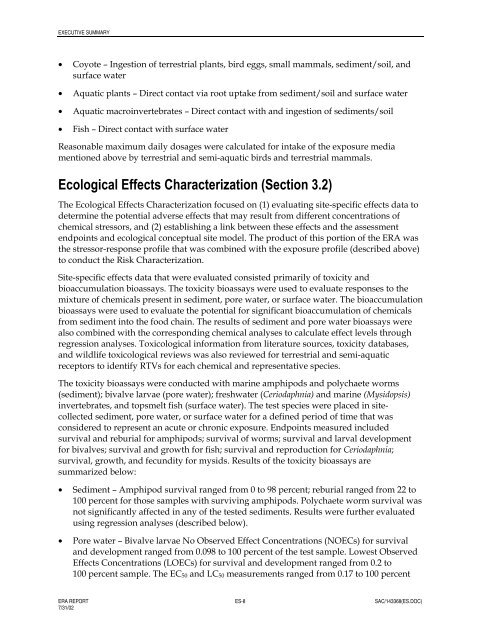1.1 MB pdf - Bolsa Chica Lowlands Restoration Project
1.1 MB pdf - Bolsa Chica Lowlands Restoration Project
1.1 MB pdf - Bolsa Chica Lowlands Restoration Project
You also want an ePaper? Increase the reach of your titles
YUMPU automatically turns print PDFs into web optimized ePapers that Google loves.
EXECUTIVE SUMMARY<br />
• Coyote – Ingestion of terrestrial plants, bird eggs, small mammals, sediment/soil, and<br />
surface water<br />
• Aquatic plants – Direct contact via root uptake from sediment/soil and surface water<br />
• Aquatic macroinvertebrates – Direct contact with and ingestion of sediments/soil<br />
• Fish – Direct contact with surface water<br />
Reasonable maximum daily dosages were calculated for intake of the exposure media<br />
mentioned above by terrestrial and semi-aquatic birds and terrestrial mammals.<br />
Ecological Effects Characterization (Section 3.2)<br />
The Ecological Effects Characterization focused on (1) evaluating site-specific effects data to<br />
determine the potential adverse effects that may result from different concentrations of<br />
chemical stressors, and (2) establishing a link between these effects and the assessment<br />
endpoints and ecological conceptual site model. The product of this portion of the ERA was<br />
the stressor-response profile that was combined with the exposure profile (described above)<br />
to conduct the Risk Characterization.<br />
Site-specific effects data that were evaluated consisted primarily of toxicity and<br />
bioaccumulation bioassays. The toxicity bioassays were used to evaluate responses to the<br />
mixture of chemicals present in sediment, pore water, or surface water. The bioaccumulation<br />
bioassays were used to evaluate the potential for significant bioaccumulation of chemicals<br />
from sediment into the food chain. The results of sediment and pore water bioassays were<br />
also combined with the corresponding chemical analyses to calculate effect levels through<br />
regression analyses. Toxicological information from literature sources, toxicity databases,<br />
and wildlife toxicological reviews was also reviewed for terrestrial and semi-aquatic<br />
receptors to identify RTVs for each chemical and representative species.<br />
The toxicity bioassays were conducted with marine amphipods and polychaete worms<br />
(sediment); bivalve larvae (pore water); freshwater (Ceriodaphnia) and marine (Mysidopsis)<br />
invertebrates, and topsmelt fish (surface water). The test species were placed in sitecollected<br />
sediment, pore water, or surface water for a defined period of time that was<br />
considered to represent an acute or chronic exposure. Endpoints measured included<br />
survival and reburial for amphipods; survival of worms; survival and larval development<br />
for bivalves; survival and growth for fish; survival and reproduction for Ceriodaphnia;<br />
survival, growth, and fecundity for mysids. Results of the toxicity bioassays are<br />
summarized below:<br />
• Sediment – Amphipod survival ranged from 0 to 98 percent; reburial ranged from 22 to<br />
100 percent for those samples with surviving amphipods. Polychaete worm survival was<br />
not significantly affected in any of the tested sediments. Results were further evaluated<br />
using regression analyses (described below).<br />
• Pore water – Bivalve larvae No Observed Effect Concentrations (NOECs) for survival<br />
and development ranged from 0.098 to 100 percent of the test sample. Lowest Observed<br />
Effects Concentrations (LOECs) for survival and development ranged from 0.2 to<br />
100 percent sample. The EC 50 and LC 50 measurements ranged from 0.17 to 100 percent<br />
ERA REPORT ES-8 SAC/143368(ES.DOC)<br />
7/31/02






